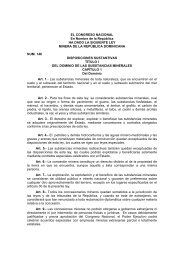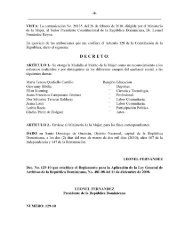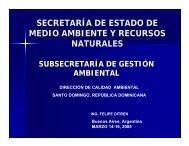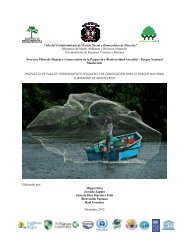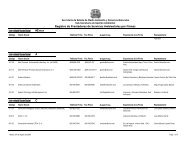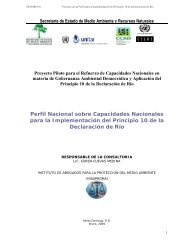CAMBIO CLIMATICO
CAMBIO CLIMATICO
CAMBIO CLIMATICO
You also want an ePaper? Increase the reach of your titles
YUMPU automatically turns print PDFs into web optimized ePapers that Google loves.
PRIMERA COMUNICACIÓN NACIONAL<br />
throughout the 21st century, but these changes<br />
will depend strongly on foreseeable climate<br />
changes. The two most contrasting scenarios<br />
are those associated with the CSIRO TR and<br />
HadCM2 models.<br />
In the scenario associated with the CSIRO model<br />
for the year 2050, taking into account the CO 2<br />
fertilization effect at its maximum expected value<br />
(BETA = 0.7), the productivity grows to 21.2% in<br />
the zone of current maximum values. However, it<br />
should be noted that in the zones of lower productivity,<br />
the impact of climate change does not<br />
change the current situation appreciably.<br />
The scenario corresponding to the HadCM2<br />
model for 2050 represents a drastic decrease in<br />
productivity and the end of Dominican forests in<br />
the second half of the 21st century. Attention<br />
should be focused on the fact that this disappearance<br />
of the forests is very different from that<br />
predicted by ecologists, environmentalists, and<br />
scholars of biodiversity as a result of the direct<br />
action of man (land use, intense exploitation,<br />
acid rain and other factors.) The difference lies<br />
in the fact that in this case we are dealing with<br />
the total disappearance of those climate conditions<br />
that allow for the potential existence of the<br />
forest. This impact could not be avoided by the<br />
usual conservation and protection measures<br />
that cannot protect the forests from the change<br />
in climatic conditions.<br />
The short-term disappearance of the climatic<br />
conditions that allow for the existence of<br />
Dominican forests, which is equal to drastic<br />
changes in the current Holdridge’s Life Zones,<br />
will not be enough time for the current species to<br />
migrate to new areas with more favorable conditions.<br />
This will be aggravated by the current<br />
fragmentation of the habitat of the ecosystems,<br />
as the potential favorable areas may already be<br />
occupied by anthropic systems and by the insularity<br />
of the Dominican Republic.<br />
Therefore, we should expect in this last scenario<br />
a massive mortality of the forests in their current<br />
locations. This phenomenon, which is referred to<br />
as “dieback” in the international literature, has<br />
been analyzed by other researchers in relation to<br />
the tropical and Amazonian forests using scenarios<br />
created with the HadCM2 model (UKMO,<br />
1998). This massive mortality will lead to<br />
increased CO 2 emissions that will accelerate and<br />
intensify climate change at levels not yet contemplated<br />
in the scenarios.<br />
1.4.3.b) Agricultural Crops<br />
Regarding crops, included are those of temperate<br />
climate and a C3 photosynthetic cycle, such as the<br />
potato, which has an unlimited growth period,<br />
warm climate crops with a C3 photosynthetic<br />
cycle, such as rice, and those warm climate crops<br />
with a C4 photosynthetic cycle, such as corn.<br />
These last two have a limited growth period.<br />
All of these were evaluated both with and without<br />
taking into account the CO 2 fertilization<br />
effect. The impact parameters used were the<br />
potential yield of irrigated lands, the water consumption<br />
required to achieve these yields, the<br />
time required for flowering in the case of rice<br />
and corn, and for the appearance of tubers in the<br />
case of potatoes. However, the results are more<br />
impacting in the case of the scenarios associated<br />
with the HadCM2 model, since in the second half<br />
of the next century it will no longer be possible<br />
to grow potatoes in the Dominican Republic.<br />
Adaptation to climate change can affect the cultivated<br />
area, specific management technology, individual<br />
sector of impact, geographical area or<br />
nation. In general, adaptation can be achieved<br />
only through the application of a series of measures,<br />
and not by one isolated measure. It is our<br />
view that climate change adaptation, as well as<br />
that of mitigation, is a problem of global character.<br />
The adaptation policies in this sector recommend<br />
taking into account the development process of<br />
the current globalization of the world economy,<br />
since not doing so could lead to (socioeconomic)<br />
disasters of still greater relevance than even the<br />
direct impact of climate change. Furthermore, it<br />
should not be expected that simple adaptation<br />
47



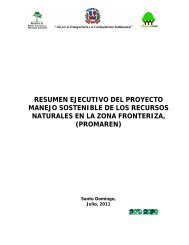
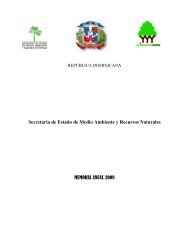

![Documento de trabajo del grupo G-77[1] EconomÃa verde en el ...](https://img.yumpu.com/50859069/1/190x245/documento-de-trabajo-del-grupo-g-771-economa-a-verde-en-el-.jpg?quality=85)




